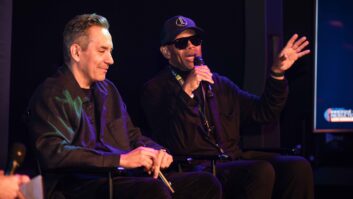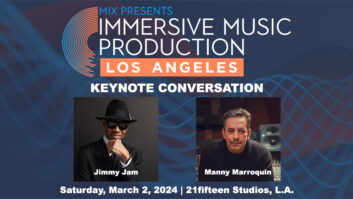After blazing their own trail in the early 1990s in what would become known as the shoegaze genre, Slowdive disbanded more than 20 years ago after being dropped by their label, Creation Records. In 2014, the band got back together to play a handful of gigs, which quickly turned to sold-out festivals and then a self-titled brand new album that has since won critical acclaim all around the world. Pro Sound News spoke with drummer Simon Scott about new life in the band’s instruments and songs.

On re-emerging:
I think initially the conversation went something like, “Do you fancy doing the Primavera Sound festival and a handful of gigs with Slowdive in Barcelona?” It just so happened that I had recently finished a project and the other guys fancied doing it as well. So we did a few warm-up shows and they sold out very quickly. At that point, we thought, “Well, this is demand for Slowdive.” We were very baffled, very surprised and very flattered. I think “astonished” was more the word when we walked out and realized there were 25,000 people who came to see us. So then we thought that maybe there are some people who have never heard of us who might like to come see us on the road to find out what we’re all about.
On igniting old flames:
We walked into the rehearsal room again and we hadn’t been all together for 20 years. It was kind of surreal—we chatted about our families, since we’ve all got children now. Then we sat down with drums, bass and guitar, set up the vocal mics, switched on the amps and said, “Let’s just try Slowdive,” and we went straight into it. And it felt almost as if we’d been in the same room together the day before. It didn’t seem like 20 years had passed at all, and there was something really quite magical about it. Of course we were really rusty with some of the parts. Nick Chaplin, our bass player, hadn’t been in a band after Slowdive split in ’95, and he hadn’t picked up a bass in 24 years or something. So he went out and got a bass guitar and relearned how to play that. Christian [Savill] and Neil [Halstead] needed to work out a few of the chords by watching YouTube videos of Slowdive at some point.
On cutting wax:
The conversations about making an album happened at the initial stages. We said, “Let’s do a handful of gigs, but let’s try and make a record.” We figured if we were awful live and if we couldn’t pull it together, we’d just play a few gigs and call it a day. But at some point we decided to go into the studio to see if we could write a bunch of songs together. What happened was that a community formed and it was a big success—five gigs turned into 50, 60 gigs. By the time we got offered a record deal, we had a bunch of record companies saying, “Look, you’ve got to get a new album out. Can we sign you? Here’s a check if you want it.” By the time that happened, though, we’d already been spending time in a bunch of little studios around England, just jamming out songs and recording them to find out if we could add anything to what we’d already released. We’d done three very strong albums in our past and weren’t sure if we could do something at that level.
Related: Music, Etc. on Pro Sound News
On sonic templates:
For a while, it took a little bit of time just to figure out what we wanted the album to sound like. I think it was one of those conscious decisions that we didn’t want it to be too crazy or experimental and that it had to work within the framework of Slowdive. We wanted the recording to sound like the band does live and have that kind of really big impact—like we’ve never really been away. The shows were such a success that we wanted to take that momentum and bring it straight into the studio. In that sense, it is kind of like a rock album because there is this sort of dynamic, really powerful live sound on this record. Towards the end of the album, I was bringing in things like signal processing software to create loops and ambient textures—I think you can hear it on that opening track, “Slomo,” which has a slightly odd kind of texture in the background.
On building off of differences:
We spend a whole lot of time listening to how we sound, and one thing I can say this go ’round is that we’ve all become much better listeners. The chemistry this time was even better than it was back in the really early days. There was a lot more support from one another, and there was a lot more listening. Neil [Halstead] is the principal songwriter, but he considers everyone’s ideas important. I think we co-wrote two of the tracks as a band, and I co-wrote the final track on the album. So even though Neil can hear the song coming into its own as it’s being recorded, it is very collaborative and it was good fun. It’s got a really good vibe on it, and I think you can hear this on the record.
On reflection:
I’m kind of here pinching myself, to be honest with you. If someone told me a decade ago that in 10 years time, I’d be getting on a plane to do sold-out shows in Australia, going on after all these successful bands even high up on the bill, and that tickets would be hard to come by, I would have laughed. And I think everyone in the band would have laughed, too. It is pretty astonishing to think, “Wow, to be able to do that again.” To have done that back in the day, and to be able to do it again is a real privilege.
Jacques Sonyieux is a devout explorer of recording studios and the artists who occasionally inhabit them.







